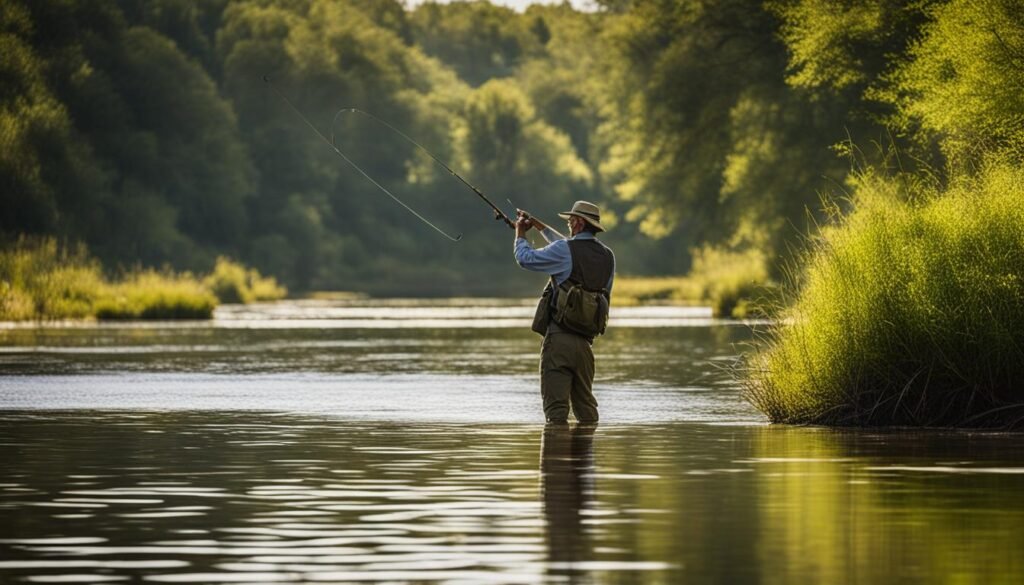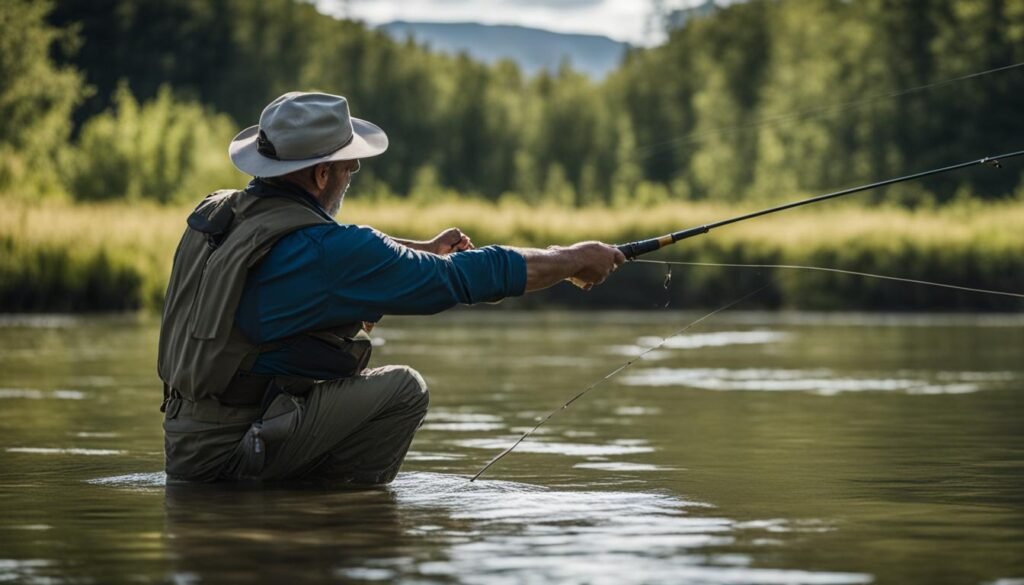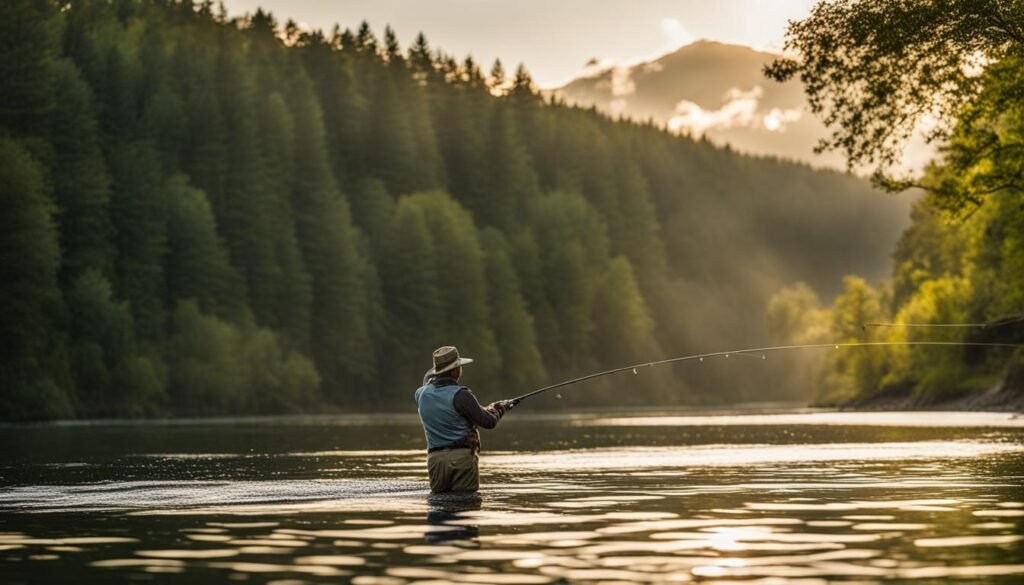Are you new to the world of fly fishing? Learning how to cast your fly effectively is a crucial skill for any beginner. In this article, we will explore some beginner-friendly fly fishing casting techniques that will help you improve your skills and increase your chances of success on the water.
Whether you’re targeting trout in a mountain stream or chasing after bass in a calm lake, mastering the art of fly casting is essential. With the right techniques, you’ll be able to present your fly accurately and attract those elusive fish.
Understand Your Fly Fishing Rod
When it comes to improving your fly fishing casting technique, understanding your fly fishing rod is crucial. It’s not just a tool for casting; it’s your partner in the art of fly fishing. By mastering the mechanics of your rod, you’ll be able to enhance your casting skills and improve your overall technique.
Start by familiarizing yourself with how to hold and move the rod during the casting process. Grip the rod firmly but not too tightly, allowing for a fluid motion. Remember that your rod is designed to do the work for you, so let it flex and load before making your forward cast.
Additionally, pay attention to the rod’s action. Different rods have varying degrees of flexibility and responsiveness. A fast-action rod is stiffer and more powerful, ideal for casting long distances. On the other hand, a moderate or slow-action rod provides a softer and more delicate presentation. Consider your fishing style and casting needs to choose the right rod action for you.
| Rod Action | Advantages | Disadvantages |
|---|---|---|
| Fast-Action | Powerful casts, long distances | Less delicate presentation |
| Moderate-Fast Action | Good balance of power and delicacy | Not as powerful as fast-action |
| Moderate Action | Smooth and controlled casts | Less power, shorter distances |
| Slow Action | Delicate presentation | Less power, shorter distances |
Take Your Time and Practice

When it comes to improving your fly fishing casting skills, one of the most important things to remember is to take your time and practice regularly. Mastery of fly casting techniques doesn’t happen overnight, so be patient with yourself and give yourself the time needed to develop your skills.
By dedicating consistent practice sessions to your casting, you’ll start to notice improvements in your accuracy and distance. Set aside some time each week to focus solely on your casting technique, away from the distractions of actually fishing. This dedicated practice will allow you to fine-tune your movements and build muscle memory, leading to more precise and controlled casts when you’re out on the water.
Remember to focus on the fundamentals as you practice. Work on your grip, your arm movement, and your timing. Pay attention to your posture and body positioning as well. It’s all about developing a smooth and fluid motion that maximizes the power and efficiency of your cast. So don’t rush the learning process – take your time and practice regularly, and you’ll see improvements in your casting technique.
Practice Tips for Improving Your Casting Technique
| Tips | Description |
|---|---|
| 1. Start with the basics | Focus on mastering the basic casting techniques before moving on to more advanced maneuvers. This will provide a solid foundation for your casting skills. |
| 2. Practice in different conditions | Vary your practice sessions by casting in different weather conditions and water environments. This will help you adapt your technique to different situations. |
| 3. Seek guidance | Consider taking lessons from a professional fly fishing instructor or joining a local casting club. Their expertise and guidance can help you identify areas for improvement and provide valuable feedback. |
| 4. Utilize visualization techniques | Visualize the perfect cast in your mind before executing it. This mental practice can help improve your muscle memory and make your casting more instinctive. |
| 5. Film and review | Record your casting practice sessions and review the footage to identify any flaws or areas that need improvement. This objective feedback can be invaluable for refining your technique. |
Manage Your Fly Line
Proper line management is crucial for improving your fly casting presentation. When it comes to line management, there are a few key factors to keep in mind. First, understanding how to hold and control the line is essential. Use your non-dominant hand to hold the line against the rod handle, with a light but firm grip. This allows you to have better control and feel of the line during your casting motion.
Another important aspect of line management is knowing when to lengthen or shorten the line. Adjusting the length of your line can greatly impact your casting distance and accuracy. Use your stripping hand to strip in or let out line as needed, keeping in mind the fishing conditions and target area. Practice different line management techniques to find what works best for you.
Line Management Tips:
- Keep a light but firm grip on the line with your non-dominant hand.
- Use your stripping hand to let out or reel in line as needed.
- Adjust the length of your line based on fishing conditions and target area.
- Practice different line management techniques to improve your casting presentation.
In addition to controlling the line length, understanding how line affects your casting is crucial. The weight and taper of the line can impact the energy transfer and presentation of the fly. Experiment with different line types and weights to find the one that suits your casting style and fishing needs.
By mastering line management, you’ll be able to achieve better casting presentations, improve your accuracy, and increase your chances of landing that elusive fish.
| Line Management Tips | Benefits of Effective Line Management |
|---|---|
| Keep a light but firm grip on the line with your non-dominant hand. | Improved control and feel of the line during casting. |
| Use your stripping hand to let out or reel in line as needed. | Ability to adjust line length for different fishing conditions and target areas. |
| Adjust the length of your line based on fishing conditions and target area. | Optimized casting distance and accuracy. |
| Practice different line management techniques to improve your casting presentation. | Enhanced fly presentation and increased chances of success. |
Understand Rod Action
When it comes to fly fishing casting, understanding rod action is key to improving your technique. Rod action refers to how the fly rod flexes and recovers after a cast. Different rod actions, such as fast-action, moderate-fast action, moderate action, and slow action, offer distinct advantages and disadvantages.
A fast-action rod, for example, is stiffer and provides more power and distance when casting. It’s ideal for casting in windy conditions or when you need to cover long distances. On the other hand, a slow-action rod offers a more delicate presentation and is better suited for smaller streams and delicate presentations.
Choosing the right rod action depends on your fishing style and the type of fishing you’ll be doing. If you’re unsure, consider a moderate-fast action rod, which offers a balance between power and finesse, making it versatile for various fishing scenarios. Experiment with different rod actions to find the one that suits your casting needs.
Comparing Rod Actions
| Rod Action | Advantages | Disadvantages |
|---|---|---|
| Fast-Action | Powerful and long-distance casting | Less delicate presentation |
| Moderate-Fast Action | Versatile for different fishing scenarios | Less power than a fast-action rod |
| Moderate Action | Delicate presentation | Less power and distance |
| Slow Action | Delicate presentation and accuracy | Less power and distance |
Don’t Neglect the Backcast

When it comes to fly fishing casting, many beginners tend to focus solely on their forward cast, forgetting about the importance of the backcast. The backcast is a crucial part of the casting technique as it builds the load in the fly rod and sets the stage for a successful forward cast and accurate presentation. To improve your overall casting technique, it’s essential to practice both your backcast and forward cast.
During the backcast, make sure to use proper technique and form. Start by keeping your elbow close to your body and your wrist straight to generate power. As you bring the rod back, accelerate smoothly and pause briefly at the end of the backcast to let the line straighten behind you. This will provide you with the momentum and energy needed to deliver a precise and accurate forward cast.
By giving equal attention and practice to both your backcast and forward cast, you’ll develop a well-rounded casting technique that allows for better control and accuracy. Remember that practice makes perfect, so dedicate some time to focus on your backcast and observe how it contributes to the final presentation of your fly.
Fishing Buddy and Self-Evaluation: Keys to Improving Your Casting Technique
When it comes to improving your fly fishing casting technique, having a fishing buddy can make a world of difference. Your buddy can provide valuable feedback, spot any flaws or inconsistencies in your casting, and help you identify areas for improvement. They can act as a second pair of eyes, offering insights and suggestions that you may not have considered on your own. Collaborating with a fishing buddy not only enhances your learning experience but also makes the journey more enjoyable and rewarding.
Another effective way to evaluate and enhance your casting technique is through self-assessment. Filming yourself while practicing casting allows you to observe your form, timing, and execution. Set up a camera or use your smartphone to record your casting practice sessions. Afterward, review the footage and analyze your technique. Look for any errors or areas that need improvement. Pay attention to your body positioning, arm movements, and the loop formation of your cast. By identifying weaknesses, you can make adjustments and work towards more precise and efficient casting.
To make the most out of self-evaluation, it’s beneficial to have a basic understanding of casting fundamentals. This knowledge will help you identify specific areas to focus on while reviewing your footage. Some key aspects to consider include your rod tip trajectory, timing between the backcast and forward cast, and the shape and size of the casting loop. By breaking down your casting into smaller components, you can pinpoint areas that need refinement and work on them individually.
Self-Evaluation Checklist for Fly Fishing Casting Technique
| Aspect | Questions to Ask |
|---|---|
| Rod Tip Trajectory | Is the rod tip following a straight line during the cast? |
| Timing | Is there a smooth transition between the backcast and forward cast? |
| Loop Formation | Are you creating tight and efficient loops, or are they too wide or inconsistent? |
| Body Position | Are you standing in a balanced and stable position throughout the cast? |
| Line Control | Are you effectively managing the fly line during the cast? |
Explore Different Casting Techniques
If you want to take your fly fishing casting skills to the next level, it’s time to explore different casting techniques. While mastering the basics is important, adding a few advanced techniques to your repertoire can make you a more versatile and effective angler.
One technique to try is the roll cast. This simple yet powerful technique is perfect for tight spaces or when you need to cast with minimal backcast room. It involves rolling the line and leader across the water’s surface, allowing you to present your fly accurately.
Another technique that can come in handy is the bow and arrow cast. This technique is useful when you need to cast under low-hanging branches or in areas with limited space behind you. It involves holding the line in one hand, pulling back the rod, and releasing the line like an arrow.
If you’re aiming for long-distance casts, consider mastering the double haul cast. This technique allows you to generate more line speed, resulting in greater distance. It involves adding an extra haul or pull on both the backcast and forward cast, maximizing the efficiency of your cast.
For situations where you need to quickly change the direction of your fly, the steeple cast is a valuable technique. It involves forming a loop in the line above your head, creating a steep angle, and then bringing the rod forward to release the loop and send your fly in a new direction.
Lastly, if you want to achieve a stealthy presentation, the tuck cast is worth exploring. This technique allows you to land your fly with minimal disturbance, perfect for challenging situations. It involves abruptly stopping the forward cast and dropping the fly line, causing your fly to “tuck” into the water.
By experimenting with these casting techniques – the roll cast, bow and arrow cast, double haul cast, steeple cast, and tuck cast – you’ll become a more well-rounded fly caster. Each technique has its own purpose and can be used in specific fishing scenarios. So, get out there, practice, and expand your casting skills!

